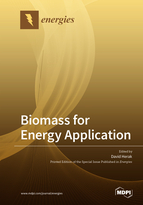Biomass for Energy Application
A special issue of Energies (ISSN 1996-1073). This special issue belongs to the section "A4: Bio-Energy".
Deadline for manuscript submissions: closed (30 September 2020) | Viewed by 39129
Special Issue Editor
Interests: biosystems engineering; agricultural engineering; energy; FEM; CAD; design of machines
Special Issues, Collections and Topics in MDPI journals
Special Issue Information
Dear Colleagues,
Considering new worldwide regulations related to the minimization of fossil fuel utilization to eliminate negative impacts on global warming and prevent the exhaustion of the resources, the utilization of biomass for energy application has become one of the most common forms of renewable energy. The development of the utilization of renewable resources has raised a number of other tasks and constraints linked to the nature of renewable resources, including the treatment, processing, conversion, and applied technologies, and, thus, a large number of critical views on this issue.
Therefore, the target of this Special Issue, entitled “Biomass for Energy Application”, of the international journal Energies, which is an SSCI and SCIE journal (2018 IF=2.707), is to critically describe the utilization of biomass for energy applications. This Special Issue mainly covers original research and studies related to the above-mentioned topics, including, but not limited to, thermochemical conversion (combustion, pyrolysis, gasification), biological conversion (fermentation, anaerobic digestation), physical conversion (pelletizing, densification, extraction), and so on. Papers selected for this Special Issue are subject to a rigorous peer review procedure with the aim of rapid and wide dissemination of research results, developments, and applications.
I am writing to invite you to submit your original work to this Special Issue. I am looking forward to receiving your outstanding research.
Prof. Dr. David HerakGuest Editor
Manuscript Submission Information
Manuscripts should be submitted online at www.mdpi.com by registering and logging in to this website. Once you are registered, click here to go to the submission form. Manuscripts can be submitted until the deadline. All submissions that pass pre-check are peer-reviewed. Accepted papers will be published continuously in the journal (as soon as accepted) and will be listed together on the special issue website. Research articles, review articles as well as short communications are invited. For planned papers, a title and short abstract (about 100 words) can be sent to the Editorial Office for announcement on this website.
Submitted manuscripts should not have been published previously, nor be under consideration for publication elsewhere (except conference proceedings papers). All manuscripts are thoroughly refereed through a single-blind peer-review process. A guide for authors and other relevant information for submission of manuscripts is available on the Instructions for Authors page. Energies is an international peer-reviewed open access semimonthly journal published by MDPI.
Please visit the Instructions for Authors page before submitting a manuscript. The Article Processing Charge (APC) for publication in this open access journal is 2600 CHF (Swiss Francs). Submitted papers should be well formatted and use good English. Authors may use MDPI's English editing service prior to publication or during author revisions.
Keywords
- Pre-treatment and treatment
- Physical conversion
- Chemical conversion
- Thermochemical conversion
- Biological conversion
- Fermentation
- Extraction
- Anaerobic digestation
- Densification
- Torrefaction
- Pyrolysis






